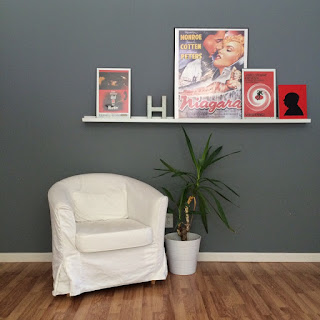I have to admit that I am very envious of people like my father-in-law or my friend Carissa who are able to grow great vegetable gardens. I've tried once or twice, and failed every time. Luckily, my father-in-law shares plenty of what he reaps- at this moment there is a giant zucchini in my kitchen waiting to go to good use. Soon, my precious. However, I have been able to successfully keep my houseplants alive. I love having plants in our house. They help with air quality and they add a vibrant texture to our decor. Most of our houseplants reside in our living room, where they get plenty of light from our giant picture window. I have been expanding though, and my most recent addition is living happily in the dining room. When that plant joined the family I repotted all our bigger pieces, and a few weeks ago while Josh was out of town I entertained myself by doing the same with our succulents. That's what got me thinking about writing this post! While it wasn't intentional, most of my plants pop up on hard-to-kill lists, which certainly makes keeping them alive much easier. Luckily several of these, like the snake plant, dracaena, and aloe also pop up on lists of plants that improve air quality. For instance, I have 5 out of 10 of the plants on So Haute's list below
My aloe plant though had seen better days. It was actually a housewarming gift from our friend Eddie in 2009 and I had yet to repot it. Which explains why it was rather unhappy. So, one recent Sunday afternoon I sat down with my coffee, Pinterest, and plant, put some Joni Mitchell on, and got to work. I followed the instructions from this pin to replant it, and so far it seems to be doing well.
Using the Miracle-Gro's Cactus, Palm & Citrus Potting Mix along with a base layer of pebbles that I used for the aloe, I also split and repotted this little haworthia limifolia that I had picked up from Ikea a few months ago. I hadn't really been paying it much attention, but when I looked at it it had two other plants that had propogated off the first one. These two got their own little pot while the mama moved up to bigger digs. And I moved this bright green thing up to a bigger house, too. I have no idea what it is and can't even remember where I got it, ha.
A few months ago I repotted the bigger plants when I picked up a new addition. It was donated in a furniture pick-up my boss and I went on. We don't sell real plants in our store, so I happily offered to take it home. It's a variety of croton, but that's all I know about it. When I moved it into a real pot I moved my jade plant, snake plant and dracaena up to bigger ones, too. For these plants I used a moisture control potting mix, since I'm not always the best at remembering to water. Thank goodness for their hard-to-kill factor, right? They also seem to be relatively happy. The snake plant is struggling a little bit, but it was a messy replant, so I'm keeping my fingers crossed it improves a bit. The dracaena really responded well, though and has gotten much taller.
For all my plants I use Ikea's Kardemumma white pots. I love the bright white color. I like nearly everything in bright white. I like nearly everything from Ikea, for that matter. The graphic patterns on them make them just a bit more interesting. Excuse my wrinkly slipcover above. I'm just not the kind of person who iron's their slipcovers. The only plant I haven't had to repot yet is the golden pothos that was a housewarming gift from Josh's mother. Those plants really are almost impossible to kill. It lives in my office and probably gets neglected more than any other plant for that reason- I'm just not in there that often. However, a quick trimming of dead leaves and a hearty dose of water, and it will spring back to life in just a day. Luckily when I planted it I put it in my biggest pot, knowing what prodigious growers they are, so I don't foresee having to move it any time soon.
To maintain all my improvements I water them once a week, if their soil is dry. Everyone seems to be happy so far. And if you don't have a green thumb, don't worry. Even I have a few fake's in my house. They're actually new additions that I bought for dark spaces or places where I know I wouldn't be able to keep a living plant successfully. For instance, in my Hippo bust that my friend Holly got me for Christmas.
So that's how my garden, er, my indoor menagerie grows. How about yours?













